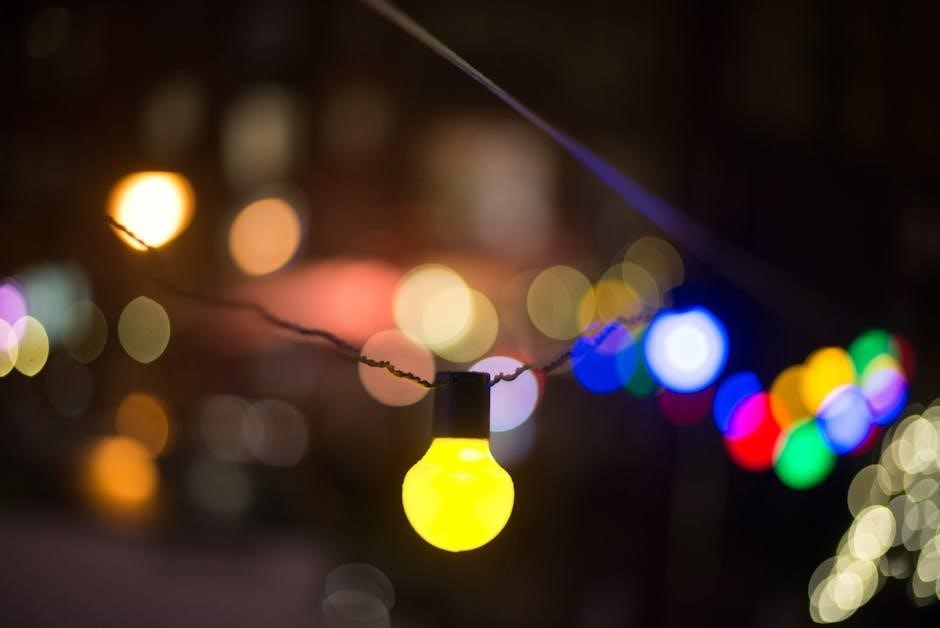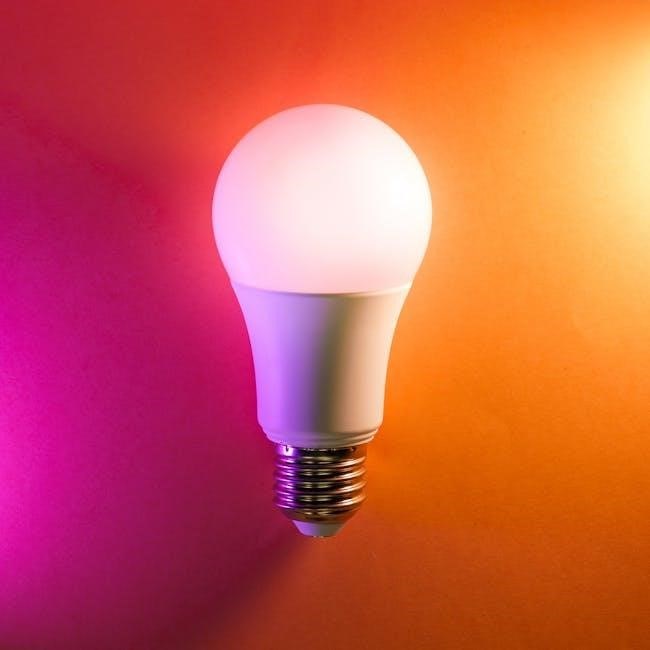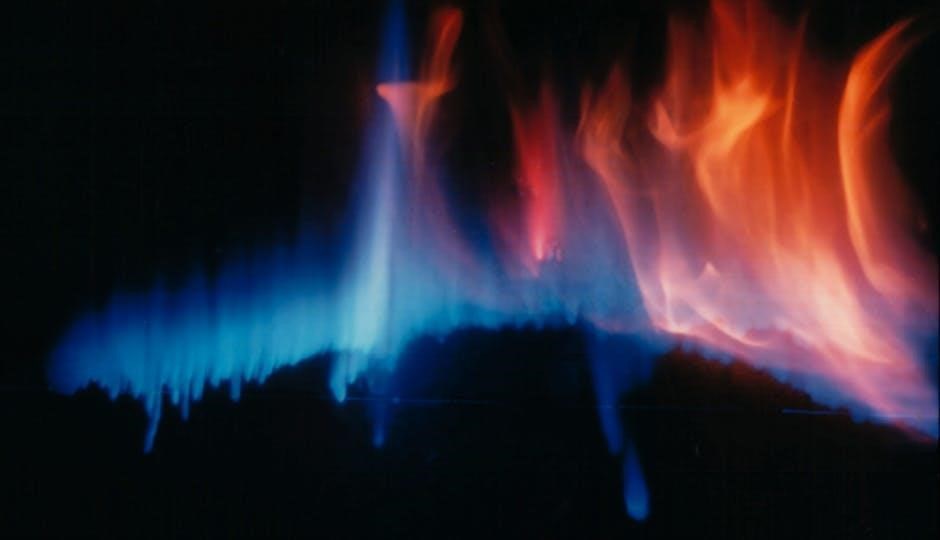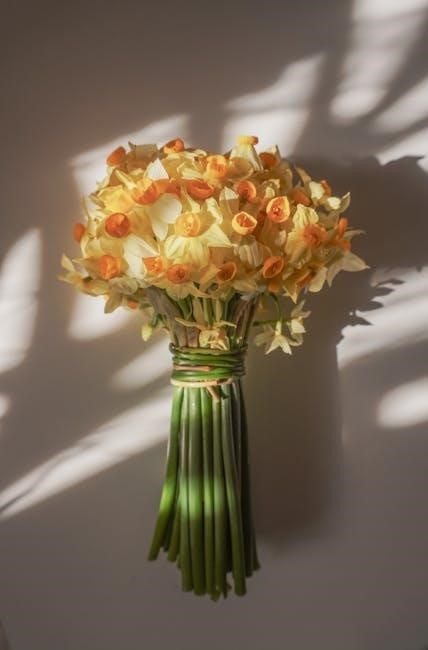

Navigating the world of light bulbs can be tricky, but understanding color temperature is key․ Measured in Kelvin (K), it defines the warmth or coolness of light․ Lower Kelvin values (2700K-3000K) produce warm, inviting light, reminiscent of traditional incandescent bulbs, perfect for creating cozy atmospheres․
Understanding Color Temperature
Color temperature, expressed in Kelvin (K), is a crucial aspect of lighting that determines the warmth or coolness of a light source․ It’s not about the actual heat of the bulb, but rather the color of the light it emits․ Think of it as the “artistic palette” of light, influencing the ambiance and mood of a space․

A lower color temperature, typically ranging from 2000K to 3000K, produces a warm, inviting glow, similar to the light emitted by traditional incandescent bulbs․ This type of light is often described as “soft white” or “warm white” and is ideal for creating a relaxing and cozy atmosphere in living rooms, bedrooms, and dining areas․
On the other hand, a higher color temperature, ranging from 4000K to 6500K, emits a cooler, more energizing light, often referred to as “cool white” or “daylight․” This type of light is similar to natural daylight and is best suited for task lighting in kitchens, offices, and workshops, where clarity and focus are essential․

Understanding color temperature allows you to choose the right light bulbs to create the desired ambiance and functionality in different areas of your home or workspace․
Kelvin (K) Scale Explained
The Kelvin (K) scale is the standard measurement used to describe the color temperature of light․ It’s a numerical scale that indicates the hue of a light source, ranging from warm (reddish) to cool (bluish)․ The scale starts at around 1,000K and extends to 10,000K, although most residential and commercial lighting falls within the 2000K to 6500K range․
Imagine heating a piece of metal: as it heats up, it begins to glow, first with a dull red color, then progressing through orange, yellow, white, and finally blue as the temperature increases․ The Kelvin scale is based on this principle, with lower numbers representing the warmer, reddish hues and higher numbers representing the cooler, bluish hues․
A light bulb with a Kelvin rating of 2700K will emit a warm, yellowish-white light, similar to that of a traditional incandescent bulb․ A bulb with a Kelvin rating of 5000K, on the other hand, will produce a bright, white light, similar to natural daylight․ Understanding the Kelvin scale allows you to select light bulbs that emit the desired color temperature for different applications;
Warm White (2700K-3000K)
Warm white light, typically ranging from 2700K to 3000K on the Kelvin scale, offers a cozy and inviting ambiance reminiscent of traditional incandescent lighting․ This color temperature emits a soft, yellowish-white glow, creating a sense of warmth and relaxation․ It’s an excellent choice for spaces where comfort and relaxation are paramount․
The warm tones of this light temperature enhance the colors of wood and other natural materials, making it ideal for living rooms, bedrooms, and dining areas․ It’s also well-suited for creating a welcoming atmosphere in lobbies and other public spaces․ This light is often preferred in cooler climates for its comforting effect․
However, warm white light may not be the best choice for tasks that require high levels of visual acuity․ The yellowish tint can sometimes make it difficult to distinguish fine details or accurately perceive colors․ For tasks such as reading, applying makeup, or working on intricate projects, a cooler color temperature might be more appropriate․
Neutral White (3500K-4000K)
Neutral white light, with a color temperature between 3500K and 4000K, offers a balanced and versatile lighting solution suitable for a wide range of applications․ As a relatively modern invention, it provides a clean, crisp light without the strong yellow tones of warm white or the harsh blue hues of cool white․ It is often referred to as “natural white” because it sits comfortably in the middle of the color temperature spectrum․
This color temperature is ideal for general-purpose lighting in homes, offices, and retail spaces․ It provides sufficient brightness for tasks while maintaining a comfortable and inviting atmosphere․ Neutral white light is particularly well-suited for kitchens, hallways, and bathrooms where a balance of functionality and aesthetics is desired․ It is also a good choice for illuminating artwork and other decorative elements․
The balanced nature of neutral white light makes it a popular choice for those who prefer a clean and modern aesthetic․ It complements a variety of interior design styles and color palettes, making it a versatile option for any space․
Cool White/Daylight (5000K-6500K)
Cool white or daylight bulbs, characterized by a color temperature ranging from 5000K to 6500K, emit a bright, crisp light that closely resembles natural daylight․ This type of light is ideal for task lighting and areas where high visibility is crucial․ The higher Kelvin temperature produces a cooler, bluer light, which can enhance focus and concentration․
These bulbs are often used in workspaces, garages, and security lighting applications where clarity and brightness are paramount․ The cool, invigorating light can help to reduce eye strain and improve alertness, making it suitable for detailed work and tasks requiring precision․ However, it’s important to note that prolonged exposure to cool white light may not be ideal for relaxation or creating a cozy atmosphere․
While some may find the starkness of cool white light unappealing for general home lighting, it can be effectively used in specific areas to enhance functionality and visibility․ When choosing daylight bulbs, consider the intended use and the overall ambiance of the space to ensure a balanced and comfortable lighting environment․
Applications by Room
Selecting the appropriate color temperature for light bulbs significantly impacts the ambiance and functionality of each room in your home․ Different spaces serve different purposes, requiring tailored lighting solutions to optimize their usability and aesthetic appeal․ The key is to consider the primary activities performed in each room and choose bulbs that complement those activities․
For instance, areas intended for relaxation, such as living rooms and bedrooms, benefit from warmer color temperatures (2700K-3000K) that create a cozy and inviting atmosphere․ These soft, yellowish tones promote relaxation and comfort․ Conversely, task-oriented spaces like kitchens and home offices often require cooler color temperatures (3500K-4000K) to enhance focus and visibility․ The brighter, more neutral light helps to reduce eye strain and improve concentration․
Bathrooms can benefit from a balance of both warm and cool light, depending on the specific area․ Warmer tones around the vanity can create a flattering effect, while cooler tones in the shower area can provide enhanced visibility․ By carefully considering the specific needs of each room, you can create a well-lit and functional home that meets your individual preferences․
Living Room Lighting
The living room, often the heart of the home, demands a versatile lighting scheme that can adapt to various activities and moods․ When selecting light bulbs for this space, prioritize warmth and comfort to create an inviting atmosphere․ A color temperature range of 2700K to 3000K, known as warm white, is generally ideal for living rooms․ This range mimics the cozy glow of traditional incandescent bulbs, promoting relaxation and conversation․
Consider incorporating multiple light sources with varying intensities to achieve a layered lighting effect․ Table lamps with warm-toned bulbs can provide soft, ambient light for relaxation or social gatherings․ Floor lamps with adjustable brightness settings allow you to customize the lighting to suit different activities, such as reading or watching television․ Dimmable overhead lights can be used to create a brighter, more energizing atmosphere when needed․
Avoid using cool white or daylight bulbs in the living room, as these can create a harsh and sterile environment․ Instead, opt for warm, inviting tones that enhance the room’s comfort and promote a sense of well-being․

Bedroom Lighting
The bedroom, a sanctuary for rest and rejuvenation, requires a lighting scheme that promotes relaxation and tranquility․ When selecting light bulbs for this space, prioritize warm, soft tones that create a calming atmosphere․ A color temperature range of 2700K to 3000K, known as warm white, is generally ideal for bedrooms․ This range mimics the gentle glow of candlelight, encouraging relaxation and preparing the body for sleep․
Incorporate multiple light sources to create a layered lighting effect that caters to different activities․ Bedside lamps with dimmable warm-toned bulbs provide soft, adjustable light for reading or winding down before sleep․ Avoid using overhead lights with cool white or daylight bulbs, as these can be too stimulating and disrupt the body’s natural sleep-wake cycle․
Consider using blackout curtains or blinds to block out external light sources, further enhancing the room’s darkness and promoting restful sleep․ Incorporate a nightlight with a very low color temperature (around 2000K) to provide a gentle source of illumination for navigating the room at night without disrupting sleep․
Kitchen Lighting
Kitchen lighting demands a balance between functionality and ambiance․ This space requires sufficient illumination for tasks like food preparation and cooking, while also creating a welcoming environment for dining and socializing․ A versatile approach is key, incorporating different color temperatures for various areas within the kitchen․
For task lighting, such as under-cabinet lights or spotlights above the stove, opt for neutral white or cool white bulbs (3500K-4000K)․ This provides bright, clear light that enhances visibility and reduces eye strain during intricate tasks․ Avoid using excessively cool or blue-toned lights, as these can distort colors and make food appear unappetizing․
For general kitchen lighting, consider using warm white bulbs (2700K-3000K) to create a more inviting and comfortable atmosphere․ This is especially important if the kitchen is also used as a dining area․ Dimmable fixtures allow you to adjust the light intensity based on the time of day and the specific activity․
Incorporate decorative lighting, such as pendant lights above the island or dining table, to add visual interest and create a focal point․ Choose bulbs with a color temperature that complements the overall kitchen design and color scheme․
Bathroom Lighting
Bathroom lighting requires careful consideration to ensure both functionality and a flattering ambiance․ The key is to create a well-lit space that is suitable for tasks like grooming and applying makeup, while also providing a relaxing atmosphere for unwinding․
For vanity lighting, it is crucial to choose bulbs with a color temperature that accurately renders skin tones․ Neutral white bulbs (3500K-4000K) are generally recommended, as they provide a balanced and natural light that minimizes color distortion․ Avoid using excessively warm or cool lights, as these can make skin appear sallow or washed out․
Incorporate ambient lighting to create a soft and inviting atmosphere․ Warm white bulbs (2700K-3000K) can be used in overhead fixtures or sconces to provide a gentle, diffused light that promotes relaxation․ Dimmable fixtures allow you to adjust the light intensity based on your mood and the time of day․
Consider using accent lighting to highlight specific features in the bathroom, such as artwork or decorative elements․ Choose bulbs with a color temperature that complements the overall bathroom design and color scheme․
Security Lighting Considerations
When it comes to security lighting, the primary goal is to deter potential intruders and enhance visibility around your property․ Color temperature plays a crucial role in achieving these objectives, as it can affect both the effectiveness and the perceived brightness of the light․
Cool white or daylight bulbs (5000K-6500K) are generally recommended for security lighting applications․ These bulbs emit a bright, crisp light that closely resembles natural daylight, which can help to improve visibility and make it easier to identify objects and people in the dark․ The cooler color temperature also tends to be more alerting and less inviting, which can serve as a deterrent to potential intruders․
Consider using motion-activated security lights to conserve energy and enhance their effectiveness․ When motion is detected, the lights will automatically turn on, providing a sudden burst of illumination that can startle intruders and alert you to their presence․
Ensure that your security lights are properly positioned to provide adequate coverage of vulnerable areas, such as entrances, walkways, and driveways․ Avoid placing lights in areas where they may cause glare or light pollution for neighbors․
Matching Color Temperature with Interior Design
The color temperature of your light bulbs can significantly impact the overall aesthetic and ambiance of your interior spaces․ Harmonizing light temperature with your interior design style can enhance the beauty of your décor and create a more cohesive and visually appealing environment․
For warm and cozy interiors, such as those with traditional or rustic décor, opt for warm white light bulbs (2700K-3000K)․ These bulbs emit a soft, yellowish glow that complements warm color palettes and natural materials like wood and stone, creating a welcoming and inviting atmosphere․
In modern or minimalist spaces, neutral white (3500K-4000K) or cool white (5000K-6500K) light bulbs can be a better choice․ Neutral white provides a clean and balanced light that works well with a variety of color schemes, while cool white offers a brighter, more energizing light that complements cool color palettes and sleek, contemporary furnishings․
Consider the color temperature of your light bulbs when selecting paint colors and décor items to ensure a harmonious and balanced look․ Experiment with different color temperatures to find the perfect match for your personal style and preferences․